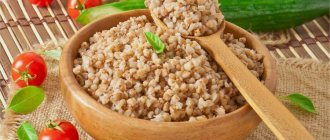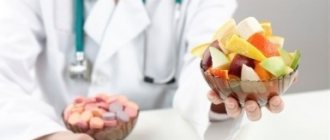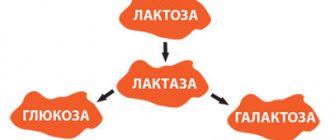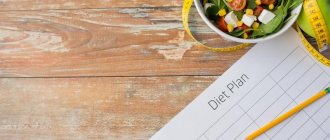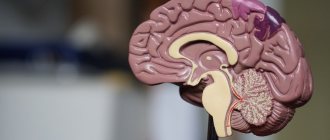What a nutritionist will prescribe for gout: briefly about the types of diets
When there is excess uric acid, gout develops.
Inflammatory joint disease is accompanied by pain and decreased mobility. The reason is the accumulation of uric acid crystals, which are formed during the breakdown of purines. These are natural substances found in our body cells and many foods. Their content is especially high in meat. Diet number 6 for gout is the recommended diet to reduce purine levels. The diet largely consists of vegetables, dairy products, and fruits. Salts, proteins, fats, products containing oxalic acid, purines and extractive nitrogenous substances are excluded or limited. Diets are followed to reduce the acidity of urine and further formation of uric acid crystals. For gout aggravated by excess weight, diet No. 6E is prescribed. It is built on the same principles, but is characterized by reduced calorie content, reduced proteins and carbohydrates. Meat and fish are allowed no more than once or twice a week. This diet for gouty arthritis is recommended not only for excess weight, but also during exacerbations.
Diet and important details
Be prepared to redistribute the number of meals: instead of the usual breakfasts “on the fly” and dinners “to the fullest”, you will have 4 meals a day, complete and balanced.
You will have to give up foods that contain a large amount of purines and oxalic acid - but we will return to this later, do not rush to be sad about a meager diet.
As for the cooking process, remember: the “first” broth for poultry and fish is not the best assistant in the fight for health.
You need to boil the meat in a large amount of water, discarding the first broth without regret.
We eat right: what will have to change in nutrition
Meals for gout are prepared according to the principles of a healthy diet. In addition to reducing the amount of proteins, preference is given to boiling, steaming, and stewing. During exacerbations, it is better to switch to a vegetarian menu with the complete exclusion of foods prohibited for gout. The daily diet is compiled taking into account the following rules:
- You can’t overeat, the portions are small, but sufficient to fill you up.
- Including recipes with fresh vegetables, seasonal fruits, semi-liquid and hot dishes in the diet for gout.
- Drinking regime is at least one and a half liters of liquid per day. Alkaline mineral water will be beneficial.
- Dividing the daily diet into four parts; eating more often is undesirable.
- Complete abstinence from alcoholic beverages.
- You cannot arrange fasting days, a hunger strike will provoke an exacerbation.
The prepared menu for gout for every day must be adhered to constantly. Errors in the diet increase the level of purines and uric acid and provoke an exacerbation of the disease.
Sample menu for gout
A therapeutic diet for gout reduces the risk of relapse of the disease, relieves pain, and normalizes the functioning of the urinary system. In addition, such a nutritional system helps normalize body weight and is one of the principles of a healthy lifestyle.
Diet for gout and high uric acid, do’s and don’ts, sample menu:
First day:
- Before meals: a glass of rose hip decoction.
- 1st breakfast: tea with milk, cabbage salad.
- 2nd breakfast: vegetable juice.
- Lunch: borscht with vegetable broth, a piece of boiled meat with white sauce (no more than 100 g)
- Afternoon snack: a glass of rose hip decoction.
- Dinner: buckwheat with milk, vegetable cabbage rolls.
- Before bed: fruit juice.
Second day:
- Before meals: a glass of rose hip decoction.
- 1st breakfast: tea with milk, beet salad, dressed with butter or sour cream.
- 2nd breakfast: vegetable juice.
- Lunch: vegetable soup with barley, cabbage schnitzel.
- Afternoon snack: fruit juice.
- Dinner: carrot cutlets, jelly.
- Before bed: watermelon or a glass of yogurt.
The list of dishes can be combined, do not forget that the effect of diet therapy can be achieved and consolidated for a long time only with its full compliance.
Harmful foods: the main enemies of gout
There will be no problems with creating a nutrition menu for gout. Doctors have clearly prescribed prohibited, unwanted and permitted products. The diet is compiled based on these lists. What foods should you not eat if you have gout?
- Pork, beef, other red meat. Particularly harmful are the legs, heads, and tails—the parts of the animal that produce the sticky broth. Strong broths, jellies, lard, and smoked meats are prohibited.
- Fish is partially limited. Salted, smoked, fried, fatty fish and canned food are prohibited.
- Animal fats (except butter), products and dishes containing them.
- Legumes: peas, beans, soybeans, chickpeas, peas.
- Alcohol.
- Spices, except salt, bay leaf and vinegar.
- Coffee, cocoa and strong brewed tea.
- Some berries are raspberries, grapes, figs.
What should you not eat in large quantities if you have gout? What foods should you limit? You should not include a lot of mushrooms, pickles, butter, and herbs in your diet. You can eat boiled meat and fish, but in limited quantities. Food for gout should be salted in moderation; it is better if the dishes are slightly under-salted. For vegetables, reduce the amount of tomatoes, radishes, celery, cauliflower, and sorrel.
What you can and cannot eat if you have gout: menu and diet No. 6
A question that interests almost all patients suffering from gouty arthritis: what can and cannot be eaten if you have gout? Based on diet No. 6, I have compiled a sample menu for people with gout or prone to it. I hope this information is useful to you. Note from Dr. Evdokimenko. The menu was slightly corrected by me - I removed some absurdities from the “classic” version of the table of this diet, and made the description of the diet more understandable. So:
Bread and flour products
Wheat and rye bread for gout can be eaten without restrictions. But some nutritionists recommend partially limiting the consumption of pastry products.
Soups
Recommended are vegetarian soups with the addition of various vegetables and cereals, again vegetarian borscht and cabbage soup, okroshka, beetroot soup, and milk soups. It is advisable to exclude from the diet or severely limit: meat and fish broths, and soups based on them; mushroom soups and broths, soups with sorrel or spinach.
Meat, poultry and eggs
Boiled beef, rabbit, chicken or turkey can be eaten relatively calmly, at least 1-3 times a week. But I’ll emphasize once again - it’s better to cook them boiled. You can also make steam cutlets from the same boiled meat. It is advisable to exclude or severely limit the following meat products in your diet: veal, chicken, lamb, pork, kidneys, liver, brains, sausages, smoked meats, canned meat. Eggs: you can eat one egg per day, maximum 2 eggs of any preparation
Fish
Low-fat boiled fish can be eaten 1-2 times a week. Fatty, salted or smoked fish, and canned fish - it is advisable to greatly limit all this or completely exclude it from your diet.
Milk and dairy products
Natural milk and dairy dishes, kefir, yogurt, natural cottage cheese and in dishes, mild cheese - without restrictions. Most nutritionists believe that they are useful for gout. Exceptions are sharp and salty cheeses, feta cheese; If you have gout, you should eat them as rarely as possible.
Pasta, cereals and legumes
Various cereals of any preparation, porridges made from them, and pasta are recommended (in reasonable quantities, of course). The exception is oatmeal, which is questionable. It is advisable to exclude or severely limit any legume products in your diet: especially beans themselves, beans and lentils, and dishes made from them.
Vegetables
Recommended: potatoes, beets, carrots, zucchini, pumpkin, sweet peppers, eggplants, white cabbage of any preparation, cucumbers - just not salted or pickled. Tomatoes are questionable. Some nutritionists call for limiting their consumption in case of gout; others claim that tomatoes are even beneficial for gout.
Note from Dr. Evdokimenko. I think that a patient suffering from gout should focus on his own condition in this matter. If your body reacts calmly to tomatoes, you can eat them without any special restrictions. But if tomatoes aggravate your condition and provoke gout attacks, your consumption of tomatoes should be limited. I would like to note that it is not common, but I have met people in whom tomatoes provoked gout attacks. Over 20 years of practice, I have had 6 or 7 such patients. Perhaps, in addition to gout, they had some other specific features in metabolism, and that is why the body reacted so strangely to tomatoes. Or the tomatoes were “chemically contaminated.”
Fruits, berries, and sweets
Recommended: any fruits and berries, both fresh and after heat treatment. Honey, jam, and sugar are also not contraindicated. Questionable - figs, raspberries, chocolate
Beverages
Considered useful: weak tea, especially with milk; weak coffee with milk, fruit and vegetable juices, rosehip decoction. It is advisable to limit: cocoa, strong tea and strong coffee. Harmful: alcoholic drinks, yeast drinks.
Note from Dr. Evdokimenko. Patients often ask me which alcoholic drinks are “less harmful” and “more harmful” for gout. According to my observations, the most potent triggers for gout attacks are beer, red wine, whiskey and cognac. Vodka, apparently, is a “purer” drink - and does not act as strongly (in small doses). But large doses of alcohol will trigger an attack no matter what you drink.
Snacks
Healthy - vegetable salads; You can eat: vinaigrette, mild cheese. Harmful: spicy or salty snacks, smoked foods, canned food, sausages.
Sauces and spices
Recommended: sauces based on vegetable broth, tomato, sour cream, milk; vanillin, cinnamon. Harmful: sauces based on meat or fish broth, mushroom broth, pepper, mustard, horseradish.
Fats
Useful: butter and vegetable oils. Harmful: lamb, beef and pork fat, cooking fats.
Article by Dr. Evdokimenko© for the book “Arthritis”, published in 2004. Edited in 2011 All rights reserved.
READ MORE:
- Classic but outdated version of the gout diet
- Gout, gouty arthritis: symptoms, signs and treatment
- No more medications needed?
- All articles by Dr. Evdokimenko
How to pamper yourself: what foods you can eat without fear
Dietary restrictions for gout are not as strict as they might seem at first. It is mainly built on the principles of healthy food. All prohibited foods can be eliminated from the diet by simply replacing them with others. What can you eat if you have gout?
- dietary meat: rabbit, turkey, chicken;
- fermented milk products, milk for making porridge, adding to tea;
- low-fat varieties of boiled fish, seafood;
- any vegetables and fruits that are not on the lists of prohibited and not recommended products;
- a moderate amount of cereals and pasta;
- vegetable oils, preferably olive or flaxseed;
- eggs, but no more than one per day;
- Sweets include marmalades, jams, marshmallows, candies without chocolate, marshmallows, honey and dried fruits (except raisins).
Errors in nutrition provoke an exacerbation of the disease, so you will have to develop healthy habits. The diet must be followed on an ongoing basis; it must become a way of life. A short-term cessation of prohibited foods will bring slight relief, but will not help in treatment.
Diet for gout during an exacerbation
During an exacerbation of gout, a properly selected diet will help get rid of unpleasant painful symptoms and restore the mobility that a person loses during the development of inflammation. You can completely exclude meat and fish products from the menu.
Nutrition for gout involves more frequent fasting days (every other day). In case of exacerbation, you can use the following menu for 1 day:
- On an empty stomach: half a glass of preheated alkaline mineral water or rosehip decoction (you can use chicory).
- Breakfast: half a serving of oatmeal porridge (it should be liquid), a glass of milk. 11 o'clock: 1 glass of apple juice. Instead, you can eat raw apples (1 pc.).
- Lunch: pureed vegetable soup (half a serving), milk-based jelly. 17 hours: carrot or tomato juice (glass).
- Dinner: half a serving of liquid milk rice porridge, 1 glass of fruit compote (strawberries, pears, apples). 21 hours: a glass of kefir.
- At night: tea with milk and honey (not advisable for diabetes) or green tea without sugar - 1 glass.
This menu can be used until the symptoms of inflammation in the legs disappear.
Recipes for gout
Recipes for gout are very easy to prepare and do not require special preparation or a specific set of products. Anyone can repeat them at home.
Light puree soup
Required Products:
- 1 carrot, 1 onion, champignons, 2 tablespoons lemon juice, ½ teaspoon sugar, 2 tablespoons sunflower oil, 30 g cream.
Preparation:
- We clean and chop the vegetables. Place the cooked carrots and onions in a pan with heated oil, put on the fire, and simmer for 7-8 minutes. Add spinach leaves and blend until pureed. Add lemon juice, sugar and let it boil; when serving, add cream to the plate.
Cottage cheese casserole
Products:
- 3 chicken eggs, 100 g semolina, 100 g sugar, 2 packs of cottage cheese, 200 g low-fat sour cream, dried fruits, salt, soda, slaked with lemon juice.
Preparation:
- Mix all ingredients thoroughly, add 0.5 teaspoon of soda, slaked with lemon juice, and raisins. Pour the resulting mass into the prepared baking dish and bake in the oven at 180 degrees until lightly browned.
Steamed chicken meatballs with gravy
Products:
- Chicken fillet 350 g, 70 g onions, 30 ml milk, 1 chicken egg, 150 g boiled rice, 70 g white bread, pepper. Salt, herbs. For the gravy: 150 g carrots, 200 ml chicken broth, 50 g herbs, 70 g onions, vegetable oil, 50 g sour cream, 15 g wheat flour, salt, pepper, green onions for serving.
Preparation:
- Cut the chicken fillet, put it in a blender, add onions, a raw chicken egg and bread soaked in milk, pepper, and dry dill. Grind thoroughly. Add boiled cold rice, fine table salt and mix the minced meatballs, let it sit for 20 minutes in the refrigerator. Form meatballs and steam for 6-8 minutes. Sauté onions and carrots, add chicken broth, herbs, wheat flour, salt to taste and sour cream. Warm up over low heat. Place the steamed meatballs into the prepared gravy and cook for another 5-6 minutes, sprinkle with green onions.
Eggplant and minced meat casserole
Products:
- eggplant, flour, vegetable oil, onion, garlic, minced meat, tomato paste, cheese, cream, black pepper, salt.
Preparation:
- Sprinkle the eggplant slices cut lengthwise with salt, pepper to taste, roll in flour and fry a little in vegetable oil on both sides. Sauté the garlic and onion until golden brown, add the minced meat and simmer for 3 minutes. Add tomato paste, pepper and salt and water (1/2 tbsp.) Simmer for another 2 minutes. Place eggplants, minced meat and grated cheese in layers in a mold, pour in cream and bake for half an hour in a preheated oven, temperature - 180˚C.
Pumpkin puree soup
Products:
- water – 1 liter; pumpkin (pre-clean) – 500 g; butter – 2 tbsp. l.; rice – 2 tbsp. l.; milk – 2 tbsp.; sugar – 1 tbsp. l.; salt - on the tip of the knife.
Preparation:
- Place diced pumpkin, washed rice, salt and sugar in a pan, add water and cook until tender. Pour over melted butter, rub everything through a sieve or grind with a blender and pour in boiled milk. Let the soup boil and season with boiled cream.
To avoid painful symptoms, seek medical help at the first warning signs and strictly follow all the recommendations of your doctor. Including those related to nutritional adjustments. An experienced nutritionist will help you create the right menu, who will tell you what you can eat with an increased concentration of uric acid, and which foods you should avoid forever.
